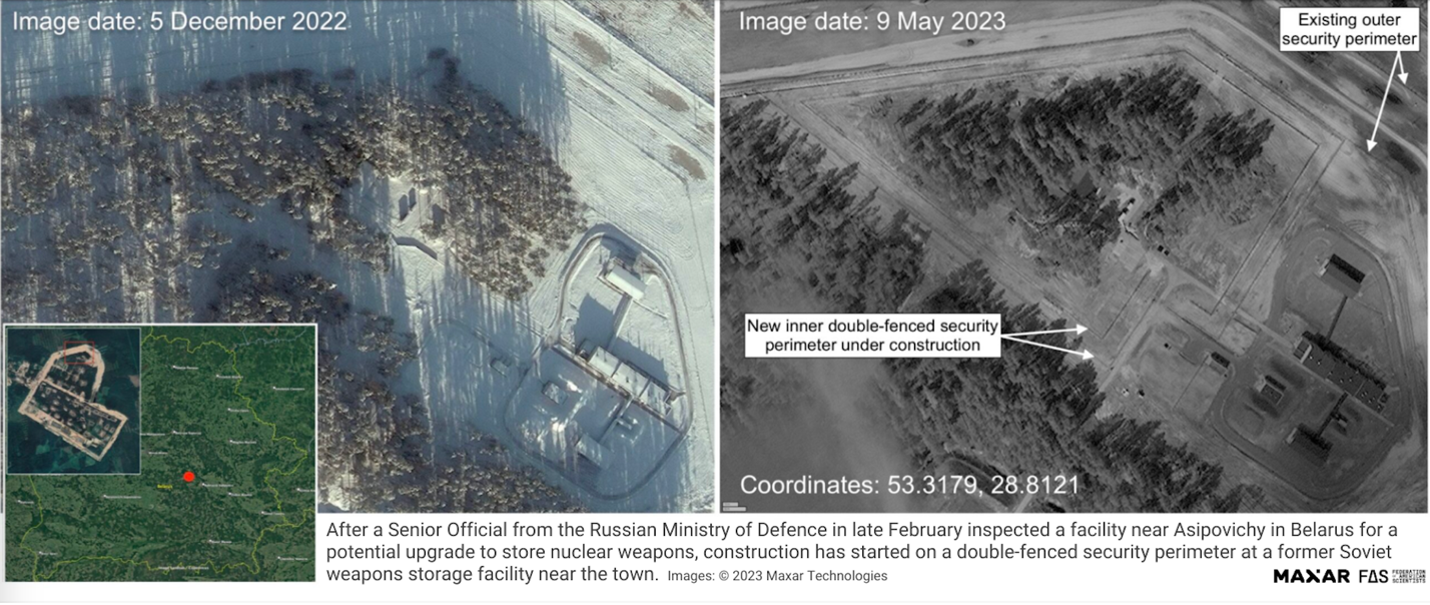
Russian Nuclear Weapons Deployment Plans in Belarus: Is There Visual Confirmation?

Shortly after a Russian defense official inspected possible nuclear weapons storage site near Asipovichy, construction of additional security perimeters began at depot.
New satellite images show that the construction of a double-fenced security perimeter is underway at a weapons depot near the town of Asipovichy in central Belarus.
The US Central Intelligence Agency reported in late-February 2023 that a senior officer from the Russian Ministry of Defense had inspected a facility in the vicinity of Asipovichy (occasionally also spelled Osipovichi) for a potential upgrade to nuclear weapons storage.
Asipovichy is the deployment area for the dual-capable Iskander (SS-26) launchers that Russia supplied to Belarus in 2022. Interestingly, the weapons depot featured in this article is roughly only 25 kilometers southeast of a vacant military base that, according to the New York Times, could be used to house relocated Wagner Group fighters in Belarus. This does not, however, imply any connection between the Wagner Group and Russian nuclear deployments in Belarus, which would be overseen by the Russian Ministry of Defence’s 12th Main Directorate (also known as the 12th GUMO).
President Vladimir Putin announced in March that Russia plans to complete a nuclear weapons storage site in Belarus by July 1st, 2023, but he later modified the timeline to July 7th-8th, apparently due to delays with preparing the storage facilities.
It is important to emphasize upfront that at this stage, we are not able to make a positive identification that this site is intended for or will definitively be used to store Russian nuclear weapons in Belarus. As we discuss in detail below, while the construction timeline and some signatures correlate with a potential nuclear storage site, other signatures do not, and these raise uncertainty about the purpose of the upgrade at the Asipovichy depot. In fact, overall, we are underwhelmed by the lack of visual evidence of the construction and infrastructure that would be expected to support the deployment of Russian nuclear weapons in Belarus. We have also surveyed satellite imagery of numerous other military facilities at locations mentioned in various reports, but we have yet to find visual evidence that conclusively indicates the presence of an active nuclear weapons facility on the territory of Belarus.
Below we survey facilities at various locations in Belarus that have been mentioned in the public debate as potential transit or deployment areas for nuclear-capable forces or even nuclear weapons.

Iskander Missile Launchers
Asipovichy is an important region because it is the location of new nuclear-capable Islander short-range missile launchers that Russia transferred to Belarus in 2022. One Belarusian news report stated the transfer happened in December, but satellite images show what appear to be Iskander launchers at the training site to the west of Asipovichy in August and October 2022 (see images below).
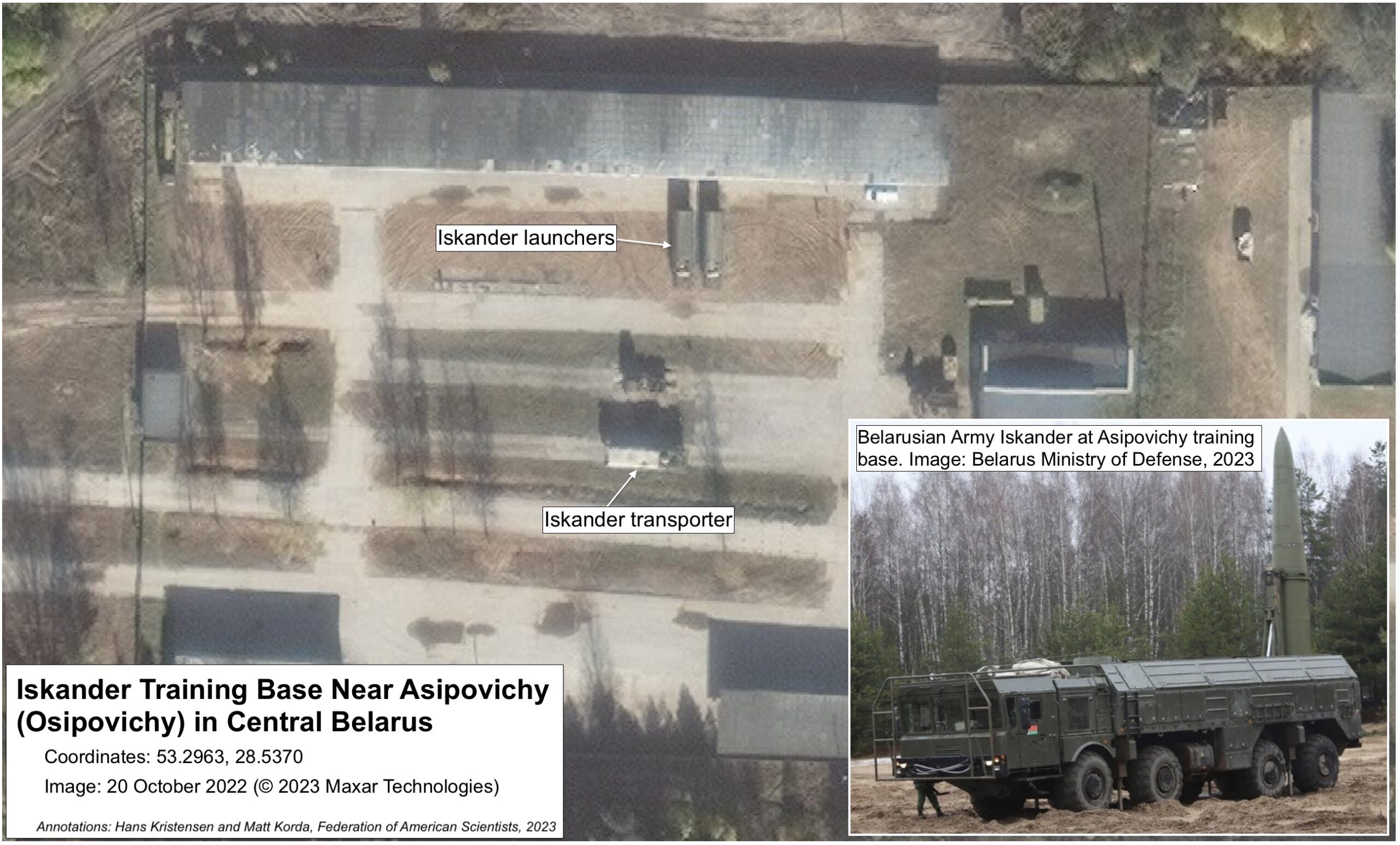
Iskander launchers have been observed at a training range west of Asipovichy several times.
The Russian Ministry of Defense announced in late-April 2023 that Belarusian personnel had completed training in maintenance and use of “special tactical warheads [Russ: “boyepripas”] for the Iskander-M operational tactical missile system” at one of Russia’s Southern Military District ranges in early April.
The Belarusian brigade base for the Iskander launchers is thought to be located in the southern outskirts of Asipovichy, roughly seven miles west of the depot undergoing upgrades. Some five miles to the west of that garrison, there is a training range where Iskander launches have been seen on several occasions (see image below).
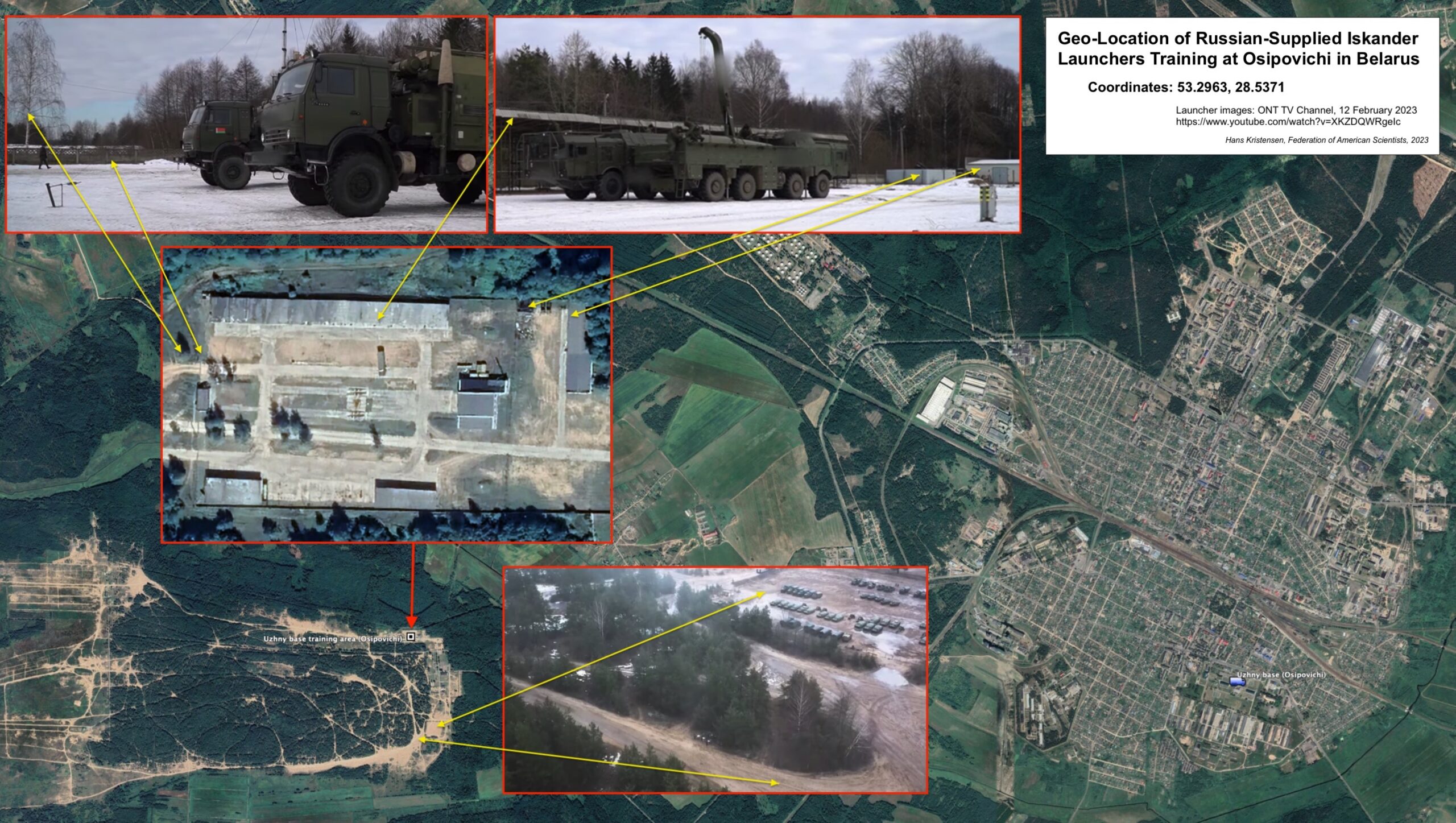
Belarusian Iskander military photos were geolocation to the training range west of Asipovichy.
Most Russian Iskander bases have extensive support facilities as well as a distinctive missile storage site (see image below). No similar facility has been found near Asipovichy. The Belarusian military probably uses different storage standards and could potentially use the dirt-covered bunkers in the south-west corner of the facility.
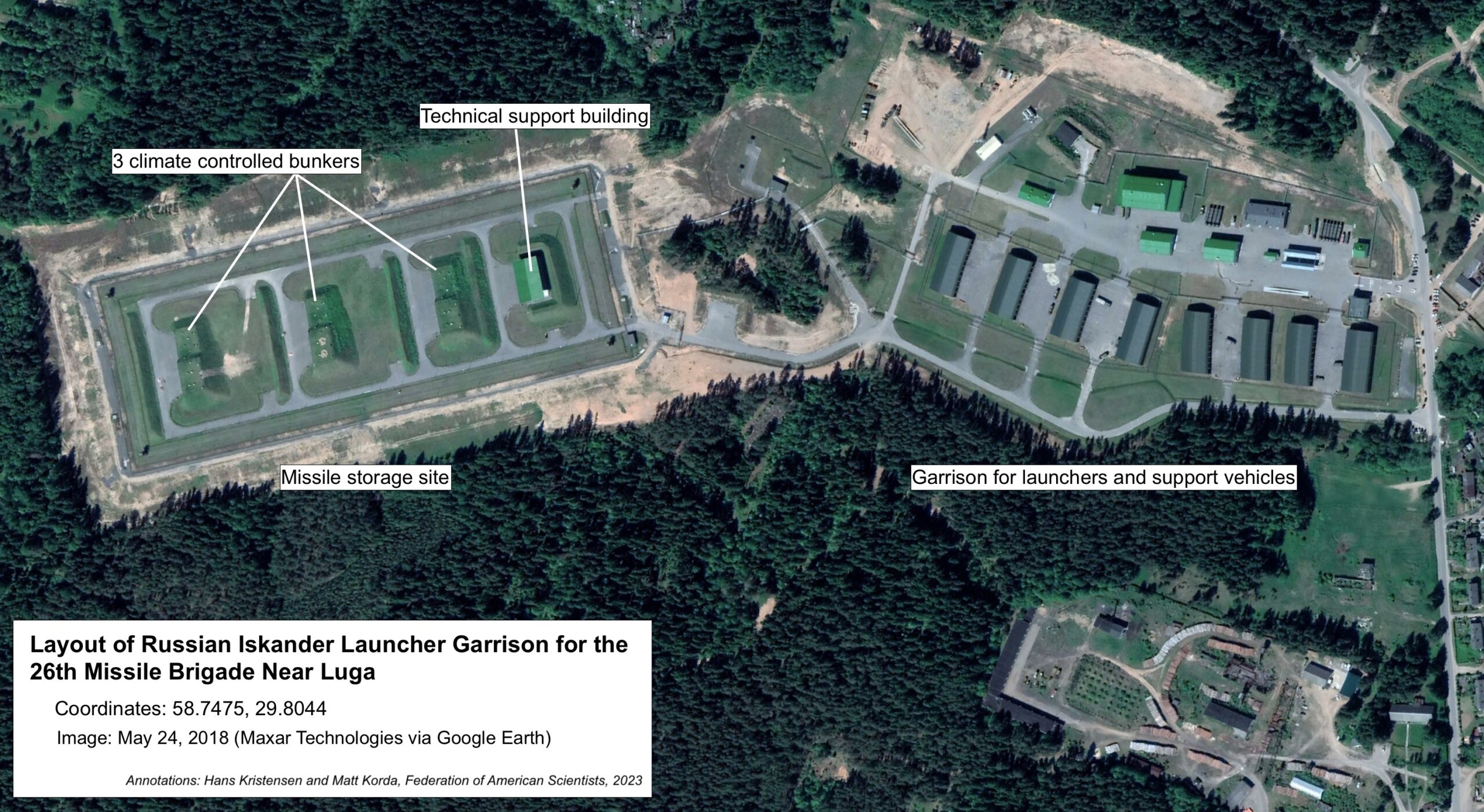
The Belarusian Iskander base does not include the distinctive missile storage site found at most Russian Iskander bases.
A few Russian Iskander bases also do not have the more elaborate missile storage site. That includes the Iskander base in Kaliningrad.
Fighter-Bomber Aircraft
In their public remarks during a meeting in St. Petersburg on 25 June 2022, Presidents Putin and Lukashenko explicitly mentioned nuclear upgrade of Belarusian Su-25 aircraft. A year later, on 14 April 2023, the Belarusian Ministry of Defense published a video of what appeared to be an Su-25 pilot at Lida Air Base explaining the new nuclear role.
An examination of the Lida base area shows no physical indications of upgrades of the kind that are thought would be required to support nuclear weapons deployment. The very latest imagery shows early construction of what appears to be an additional security perimeter around the munitions storage area at the base (see image below). It is too soon to tell, but as in the case of the Asipovichy upgrade, a second fence security perimeter does not necessarily suggest a nuclear weapons upgrade; it could simply be improvement of an existing security infrastructure.
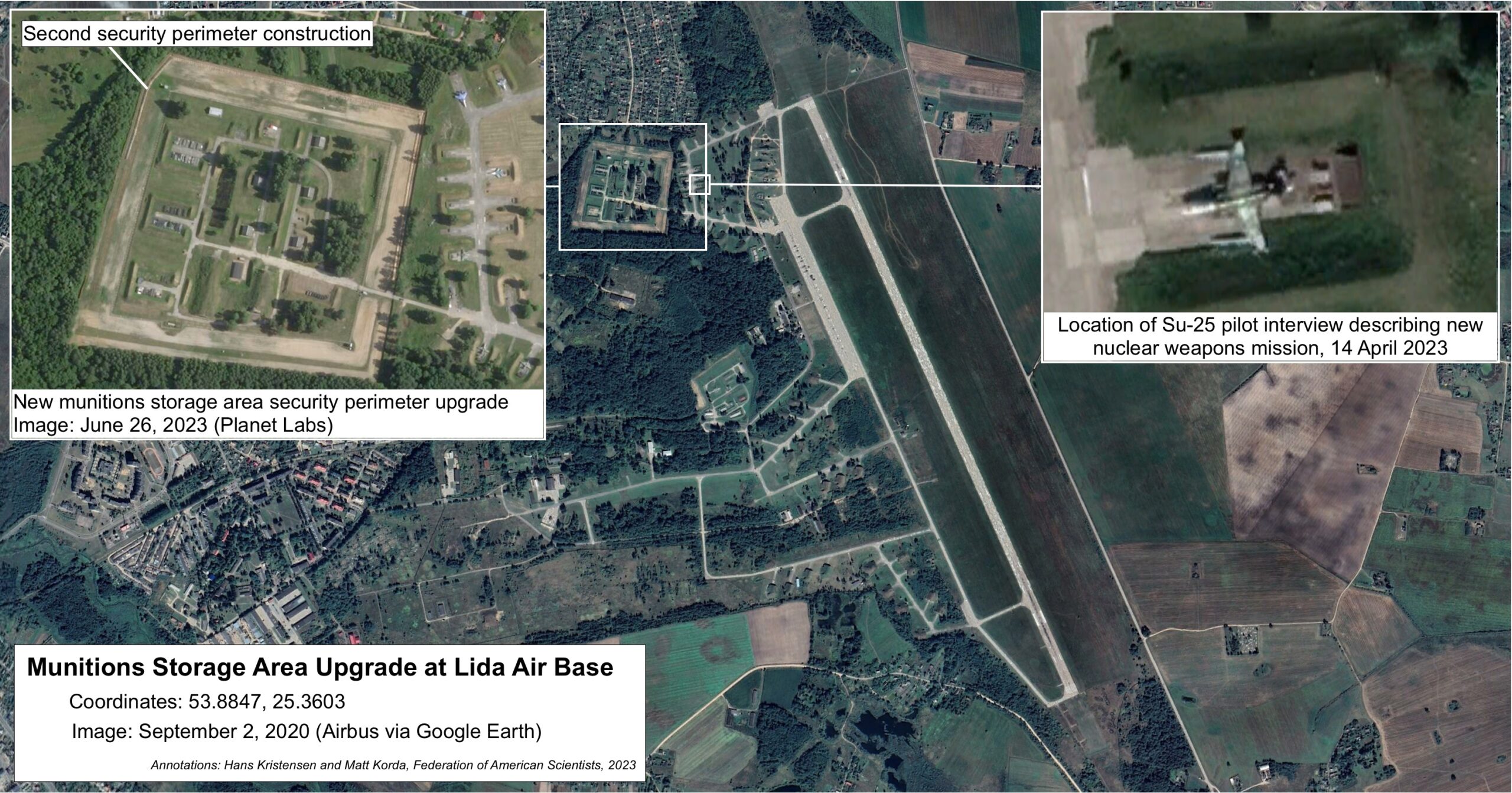
Construction of a second security perimeter at Lida Air Base has begun but there is yet no clear indication this is related to nuclear weapons.
There have also been some speculations that the Baranavichy Air Base further to the south, which is equipped with more modern Su-30SM jets, might be a potential candidate for the nuclear mission. We are not aware of any official statements to that effect and have not seen any observable indications of physical upgrades needed to support nuclear operations there.
As with the Iskander base area upgrades near Asipovichy, we can’t positively exclude the existence of an undetected facility near the western air bases. But so far, we don’t see conclusive physical indications of nuclear weapons related upgrades on or near Lida or Baranavichy. It is also relevant to mention that both bases are very close to NATO territory; Lida is only about 20 miles (35 kilometers) from Lithuania.
Warhead Transportation
On June 16th, Putin announced: “The first nuclear weapons have been delivered to Belarus, but only the first batch. There will be more. By the end of the summer, by the end of this year, we will complete this work.”
Careful monitoring of the 12th GUMO’s transit hub at Sergiev Posad has not yet indicated the shipment of specialized nuclear-related materials, such as fencing, certified loading equipment, vault doors, or environmental control systems. However, on June 27th, a group that monitors the Belarusian railway industry reported that nuclear weapons and related equipment would be delivered to Belarus in two stages, one in June and one in November––echoing Putin’s delivery timeline. The group reported that the shipments would involve three departures planned from Potanino, Lozhok, and Cheboksary stations in Russia, arriving at Prudok station in Belarus––more than 200 kilometers north of the Asipovichy depot. These locations in Russia are hundreds of kilometers away from known nuclear storage sites, and so could either be locations for subcomponents or security equipment rather than the warheads themselves, or they could potentially be an attempt to obfuscate where the warheads would actually be coming from.
Preparation of rail transfer points and storage would require construction of a number of unique security features and support facilities. An examination of satellite images of the Prudok station area in Belarus, however, revealed no observable indication of construction needed to safeguard nuclear weapons (see image below).
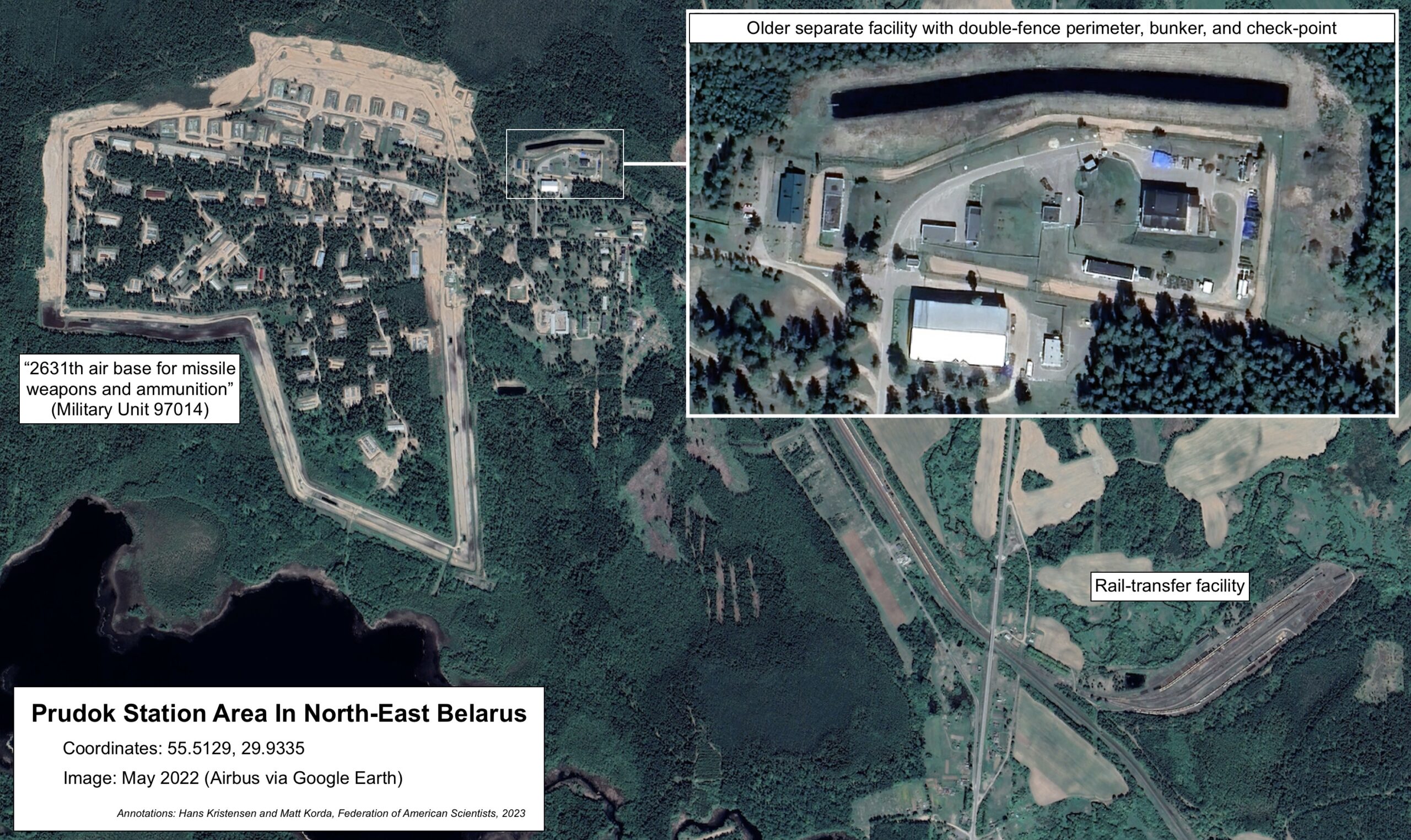
Satellite imagery of the Prudok rail station and depot area reported as the first transfer point of Russian nuclear weapons into Belarus show no observable indication of preparations to nuclear weapons storage.
Many Uncertainties
It is important to be clear that these satellite images do not prove decisively that the construction at Asipovichy or other known facilities is related to nuclear weapons storage. It could potentially be related to non-nuclear weapon systems, such as air-defense missiles. There are several uncertainties that should be mentioned and carefully considered:
First, the security perimeter has two inner fences, less than the three or four normally seen at Russia nuclear weapons storage sites. This is a significant difference, because the standard of at least three layers of fencing is directly correlated with the ability of the fence disturbance system to detect security threats to the complex. Fewer layers of fencing (and thus less clear space) could cause the microwave detection system to be accidentally triggered by movement inside the complex itself. To avoid that, vegetation has been removed along the new 12-meter wide inner security perimeter. Construction is ongoing and there is so far no visual indication of electronic sensors inside the new perimeter.
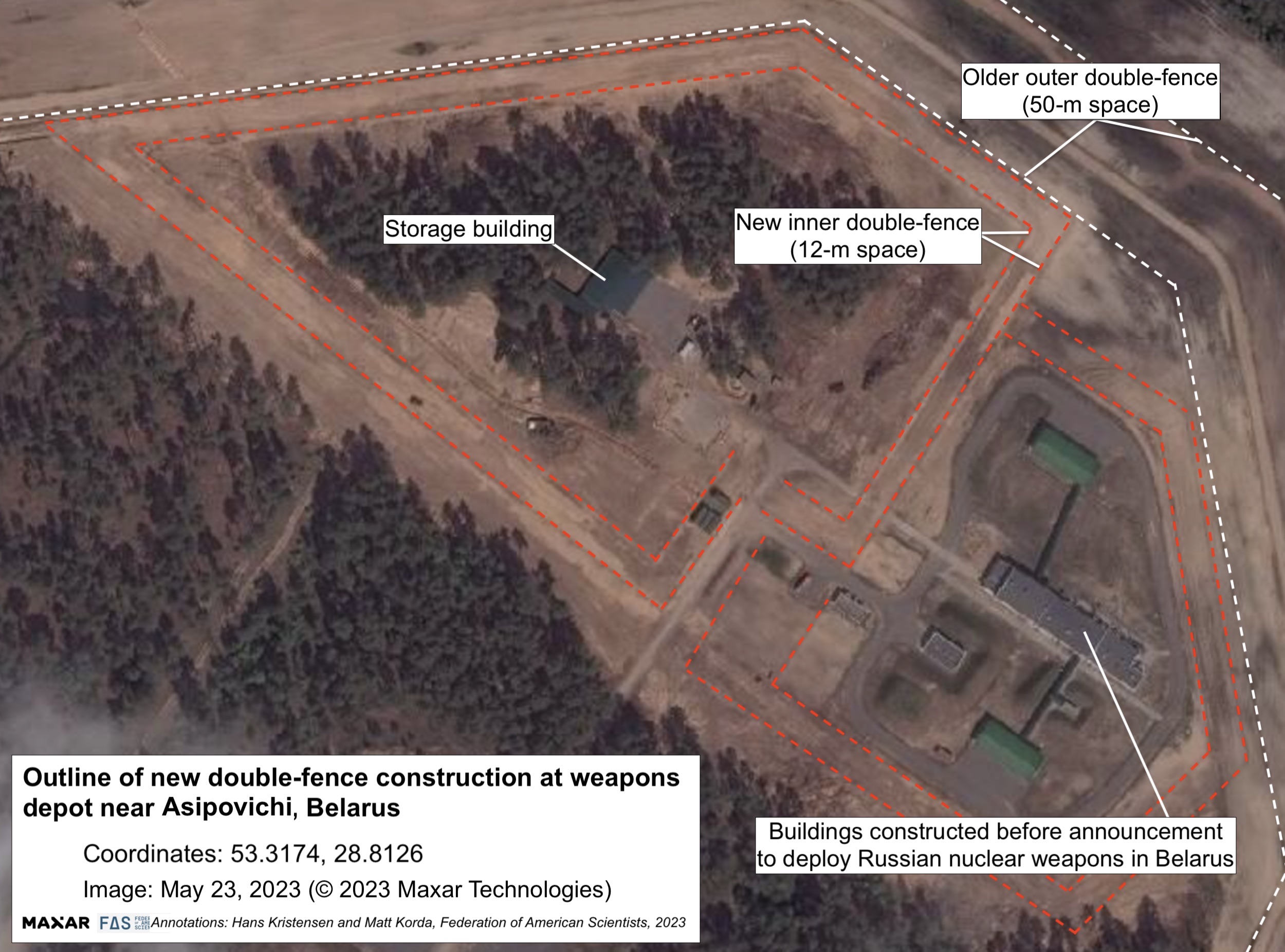
Construction of an additional double-fence security perimeter began at a weapons depot east of Asipovichy in central Belarus shortly after a senior Russian defense official inspected a facility in the area for potential storage of nuclear weapons
In comparison, Russian base- and national-level nuclear weapons storage facilities have extensive security features. The base-level storage facility near Tver approximately 325 kilometers (200 miles) from the Belarusian border has considerably stronger security features around the weapons bunkers (see image below).
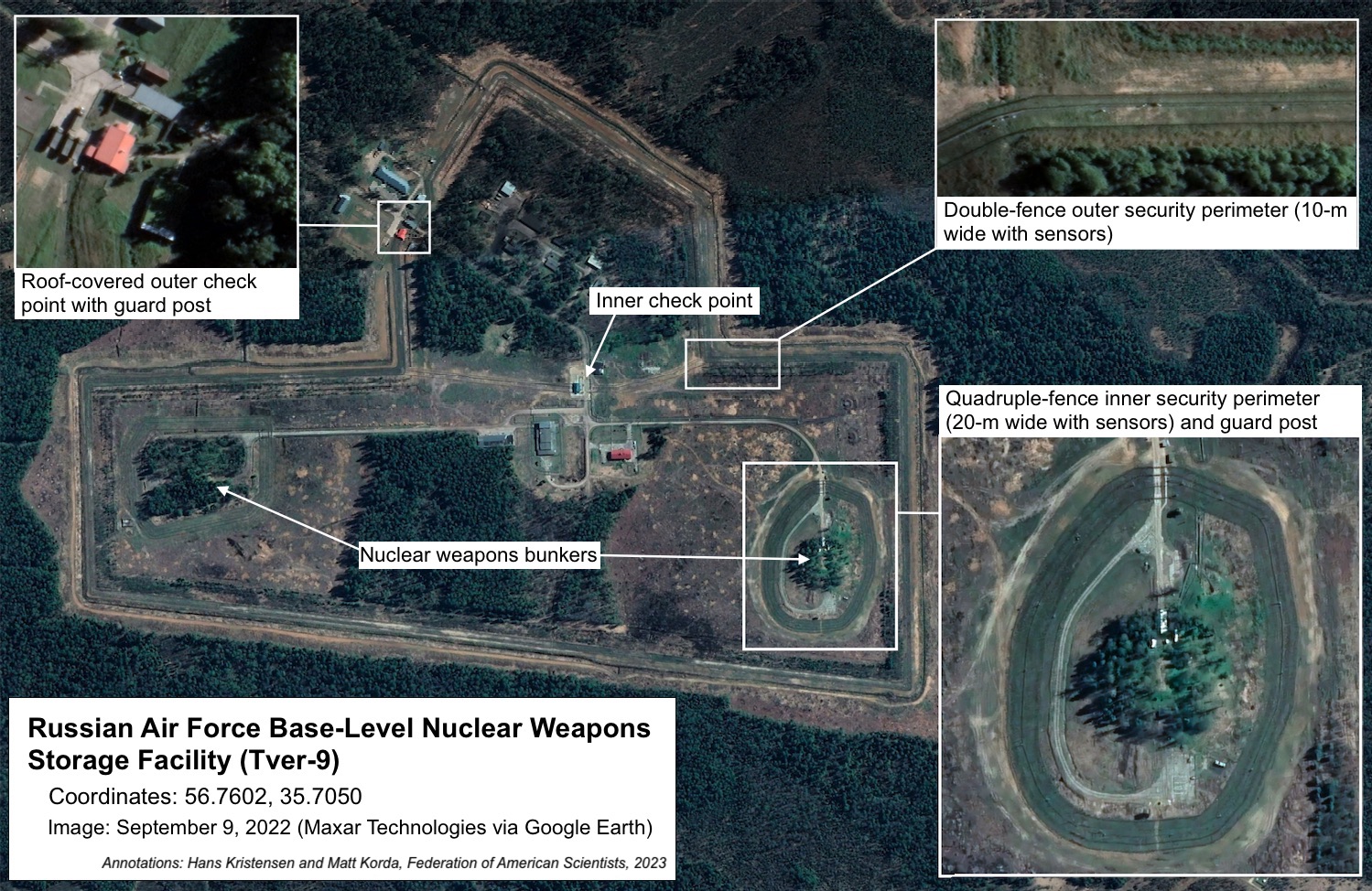
The outline of this Russian base-level nuclear weapons storage site near Tver is very different from the Asipovichy site.
Second, there is no bunker visible inside the enclosure, another normal feature of Russian nuclear weapon storage sites. Apart from physical protection, nuclear weapons require climate-controlled storage facilities.
Third, there is no visible segregated housing for the large number of Russian 12th GUMO personnel that would be needed to protect and manage nuclear warheads.
Fourth, the depot is next to a storage site for conventional high explosives. As other researchers have pointed out, it would be highly unusual for conventional and nuclear warheads to be stored within the same perimeter in order to maintain the security of the warheads and to segregate the chain of custody between Russian 12th GUMO personnel and Belarusian army personnel.
These differences could potentially be explained if the Belarusian site is a temporary transit site and not intended for permanent storage, but rather to introduce nuclear weapons in a crisis.
It is also curious that part of the new double-fence construction extends around a group of buildings that were constructed in 2017-2018, long before any statements were made about deploying Russian nuclear weapons in Belarus.
Even if Russia intends to follow through on its planned construction of a storage site in Belarus, it is not guaranteed that any nuclear weapons would actually cross the border in peacetime. Rather, it is possible that Russia’s actions instead constitute the building blocks for a potential future decision on deployment. Moreover, some analysts have suggested that these actions could be deliberately designed to remind the West of Russia’s nuclear-armed status, rather than actually shift Russian force posture.
In total, the facility upgrade at Asipovichy is important to monitor given the CIA report about Russia nuclear-related storage inspections in the area. So far, however, our observations and analyses show no clear observable indicators of construction of the facilities we expect would be needed to support transport and deployment of Russian nuclear weapons into Belarus. As always, we don’t know what we don’t know and it is of course possible that there are other facilities that we are not aware of that would indicate nuclear weapons activities.
Positive identification of this and other potential facilities will have to await additional information. And we look forward to the contribution of other researchers.
This research was carried out with generous contributions from the John D. and Catherine T. MacArthur Foundation, the New-Land Foundation, Ploughshares Fund, the Prospect Hill Foundation, Longview Philanthropy, the Stewart R. Mott Foundation, the Future of Life Institute, Open Philanthropy, and individual donors.
The Federation of American Scientists applauds the United States for declassifying the number of nuclear warheads in its military stockpile and the number of retired and dismantled warheads.
North Korea may have produced enough fissile material to build up to 90 nuclear warheads.
Secretary Austin’s likely certification of the Sentinel program should be open to public interrogation, and Congress must thoroughly examine whether every requirement is met before allowing the program to continue.
Researchers have many questions about the modernization of Pakistan’s nuclear-capable aircraft and associated air-launched cruise missiles.